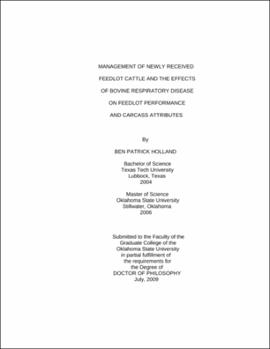| dc.description.abstract | The effects of serum haptoglobin (Hp) concentration on growing phase performance and Bovine Respiratory Disease (BRD) morbidity and mortality was evaluated using 337 heifer calves (initial BW = 241.3). Heifers were allocated into pens according to serum Hp concentration measured on arrival and classified as LOW (< 1.0 µg/100 mL), MED (1 to 3 µg/100 mL) or HIGH (> 3.0 µg/100 mL). Across the entire 63-d growing phase, ADG and DMI were similar among Hp treatment groups, but ADG and DMI were lowest for HIGH heifers during the first 7 and 21 days, respectively. Overall morbidity and the number of heifers requiring 3 treatments were greater for MED and HIGH than LOW. Following the growing phase, 193 heifers were selected for a finishing experiment in which they were classified into pens based on the number of BRD treatments they received during the growing phase. Heifers were never treated for BRD (0X), treated 1 time (1X), 2 times (2X), 3 times (3X), or were considered chronically ill (C). Disease incidence decreased ADG during the growing phase so that initial BW for the finishing phase was linearly decreased as the number of BRD treatments increased. During finishing, a compensatory response was observed in treated heifers so that final BW and carcass characteristics for those were similar to healthy heifers. However, an additional 18 days on feed was required for 3X heifers to produce those carcasses. Retail shelf life, tenderness, and palatability attributes were not different between BRD treatment groups. A third experiment used 536 steers (initial BW = 284.4 kg) to evaluate four methods of adaptation to a high-concentrate diet during a 60-d growing period. Experimental treatments were: 1) a traditional program in which three diets with an increasing percentage of concentrate from 65% to 80% were fed ad libitum during the first 21 d prior to feeding an 88% concentrate diet; 2) ad libitum feeding of the same 65% concentrate diet as in TRAD for the first 28 d, followed by adaptation to and feeding of the 88% concentrate diet; 3) the step-up diets of treatment 1 were used, except maximum feed intake was limited to 2.1, 2.3, and 2.5 times the arrival maintenance energy requirement for weeks 1, 2, and 3, respectively; and 4) program-feeding of the 88% concentrate diet from d 1. Limiting maximum intake of steers, or extending the period during which a higher-roughage diet is fed during dietary adaptation can decrease BRD morbidity. Efficiency of subsequent program-fed gain is decreased for steers fed on an extended ad libitum adaptation program during the growing phase. | |
